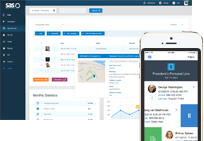- Log In
- Support
- Company
- Contact Us
- Live answers @ 1-888-532-4794
5 Reasons Why Fully Automated Customer Service Is A Rotten Idea
Over the last decade, technology has evolved at an alarming rate. From face recognition in our smart phones to cars that drive themselves, it’s amazing how much technology is a part of our everyday lives. While I think we can all agree that robots are awesome, businesses should not be so quick to use robots to replace live people – at least for their customer service. Unless you don’t care about your customers at all, we’ve listed 5 reasons why you should not be replacing your human staff for fully automated customer support.
#1. Users want immediate answers.
Auto-attendants are great at routing calls to the right agent, but they can’t do customer service well. As technology continues to evolve, consumers are becoming more and more accustomed to getting information with just a few clicks or a ‘Hey Alexa’ shout out. Like Veruca Salt, your customers want answers now. The longer your auto-attendant process is and the more options your callers have to press through to reach the end of the maze, the more likely they are to hang up. As an answering service business, we actually dig IVRs, but not as a single solution. We recommend using IVRs as part of a larger whole. If you’re going to use an auto-attendant, consider these tips:
- Make the greeting short and sweet so that your callers can get through to a live voice as quickly as possible. Limit your options in any menu to no more than 4 options, and ideally 2 or 3.
- If they’re calling for simple questions like your business hours and address, have an IVR option be a recording that will relay all of that information instead of having your callers sit through the menu options each time they call.
- Always have a press 0 auto-attendant option route to your answering service to answer simple questions via your FAQs so your callers can get the information they need from a real person. If your callers are asking questions the operators are not able to answer, they can at least take messages or transfer the call, whereas your auto-attendant would simply hang up. Rude!
- Have a live voice record your auto-attendant messages instead of a computer. The live voice gives your company a personal touch and will be easier for your callers to understand.
#2. Nothing compares to a live voice.
Sometimes auto-attendants are necessary, like when you want your callers to choose 1 to speak with an English representative or 2 to speak with a Spanish representative. However, nothing compares to speaking to an actual human being that can hear their concerns, understand what they are asking for, and ultimately come up with a resolution.
Even if you’re using an answering service and the agent isn’t able to immediately help the caller, they can still take a message and assure them their call will be returned in a timely fashion. This approach is a lot better than having your customers leave a voicemail, as they won’t be certain when or even if their call will be returned.
#3. Auto-attendants aren’t always right.
Technology is only as smart as it’s creator. If your business or answering service is using an auto-attendant, you’ll want to make sure it’s always relaying the most up to date information. For example, if you have an extension list for callers to choose who they want to speak with, make sure it has the most current employees. Sometimes callers will find that the staff member they wish to speak with no longer works there, but their name still appears as an option. Or, worse yet, if a new hire isn’t included in the dial by name directory.
In addition, businesses often times move locations or add temporary holiday messages but then forget to update their automated greetings. While small, all of these hiccups can give your business a bad look as customers may think you’re not on your game. I love Christmas as much as the next person, but having a business wish me a Merry Christmas in March just isn’t cool.
#4. Your customers don’t feel heard.
While IVR services (interactive voice response) can mean pressing different options on the keypad to get to a specific department or person, the true meaning of IVR means the caller is speaking into the phone to the machine to be directed accordingly. Often times you’ll see this option with telecommunication companies like Comcast or Verizon. While it seems like a more technologically advanced solution, it can be quite annoying if the caller has to keep repeating themselves because the attendant can’t figure what they’re saying, or if the callers’ option isn’t pre-programmed and the IVR is left confused.
When the caller does finally get through to a live agent, IVR hell has them worked up which makes for an unpleasant experience for the support rep on the other line. While CSRs are supposed to remain calm and collected no matter what the situation, no body likes to be yelled at, especially if it can be avoided with live operator love.
#5. Callers want options.
Relatively speaking, many people enjoy helping themselves and may actually prefer using an auto-attendant over having to speak to a real person. However, there are just as many people who still like the personal touch of talking to another human when they need help. You should give your callers the option to choose how they want to be assisted instead of just giving them one option over the other.
It’s helpful if your auto-attendant offers callers a choice on how they’d like to continue. For example, if they’d like to continue with the self service route, they can press 1 to be taken to the directory of options. If they would like to speak to a live person, press 2 or say ‘Operator’. It’s also a good idea to make it known that if they choose the self-service option and change their mind, they can press 0 at any time to either be taken back to the main menu, or be transferred directly to a customer service agent. While auto-attendants are helpful, they should not be the primary means of support for your customers. Ultimately, auto-attendants are the most effective when they are working in tandem with real agents.
Categories
- Advice (32)
- Answering Service 101 (18)
- Best Practices (10)
- Call Center Jobs (6)
- Call Center Software (20)
- Comparison (2)
- Customer Service (30)
- Funny (31)
- Holidays (19)
- Industry Hacks (19)
- Infographics (53)
- International (1)
- Medical (8)
- News (12)
- Phone Etiquette (2)
- Phones (14)
- Pricing (8)
- Quizzes (3)
- Receptionist (11)
- SAS Products (29)
- Scripting (4)
- Services (5)
- Small Business (25)
- Starting Up (7)
- Tips and Tricks (19)
- Uncategorized (1)
- Videos (19)
- Workplace (6)
Recently writen
- Call Center Script Best Practices: Advanced Script Block Tips to Optimize Your Answering Service
- January 2025 Release Notes – Adjustments to Call Details Timeline, New Scripting Updates, Live Transcription, and more!
- April 2024 Release Notes – Voicemail Greetings, Ability to Access Websites With a Username and Password, and more!
- March 2024 Release Notes – New Add-On, Settings Revamp, and more!
Follow Us
How about a demo?
We'll show you how our web portal works and answer any questions you have about SAS.
Schedule a demo







